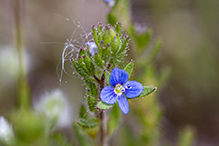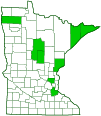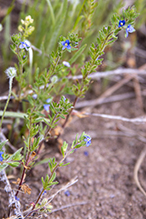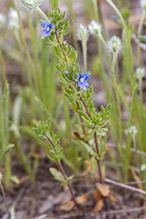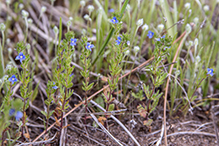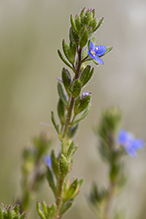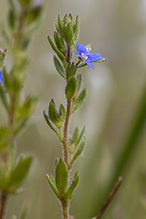spring speedwell
(Veronica verna)
Conservation • Description • Habitat • Ecology • Use • Distribution • Taxonomy
Conservation Status |
|
|||||||
| IUCN Red List | not listed |
|||||||
| NatureServe | NNA - Not applicable SNA - Not applicable |
|||||||
| Minnesota | not listed |
|||||||
Description |
||
Spring speedwell is an uncommon but rapidly spreading exotic weed. It is native to Europe, Asia, the Indian subcontinent, and Morocco. It was introduced into North America and is now naturalized and rapidly spreading in two widely separated ranges. The eastern population is in the upper Midwest from Ohio to Minnesota and in Canada from New Brunswick to Ontario. The western population is from Washington to Wyoming and in British Columbia. It is uncommon throughout its range, currently rare in Minnesota. It is found in meadows, pastures, lawns, roadsides, trailsides, campgrounds, and parking lots. It grows in full sun in dry, sandy, gravelly, and rocky places with poor soil where it receives reduced competition form other species. It is difficult to see when standing upright, is easily overlooked due to its small size, and is very similar in appearance to the much more common corn speedwell. For these reasons, it is probably under-reported. Spring speedwell is an erect, annual forb that rises on a single stem from a taproot. It can be 2″ to 10″ tall but in Minnesota it is usually no more than 6″ in height. The stem is usually unbranched but sometimes has a few branches near the base that curve upward becoming more or less parallel to the main stem. It is moderately covered with white, curly, non-glandular hairs and also with gland-tipped hairs, especially in the inflorescence. The leaves below the inflorescence are opposite while the leaf-like appendages (bracts) within the inflorescence are alternate. Leaves on the lower stem are short-stalked, while those in the middle and above are stalkless. The leaf blades are egg-shaped (widest below the middle) to broadly elliptic (widest at the middle), 3 ⁄16″ to ½″ (5 to 12 mm) long, ⅛″ to ¼″ (4 to 7 mm) wide. Many leaves have 2 to 6 narrow lateral lobes, shallow lobes on the lower leaves, very deep lobes on the upper leaves. The upper and lower surfaces are moderately covered with both short, stiff, non-glandular hairs and spreading, gland-tipped hairs. The margins may be toothless or have a few shallow, rounded teeth. The lower leaves wither, turn brown, and fall away as the plant matures. The inflorescence is a moderately dense, unbranched arrangement (raceme) of many flowers at the end of the stem and branches. Each flower is on a short, 1 ⁄64″ to ⅛″ (0.5 to 2.5 mm) long stalk. At the base of each pedicel there is a single bract. Lower bracts are lance-shaped and lobed. Upper bracts are long and straight-sided (linear), unlobed, and untoothed. Each flower is 1 ⁄16″ to ⅛″ (2 to 4 mm) wide. There are 4 outer floral leaves (sepals), 4 petals, and 2 stamens. The sepals are green, ⅛″ to 3 ⁄16″ (3 to 5 mm) long, and covered with gland-tipped hairs. They are fused at the base into a short calyx tube, then separated into 4 narrowly lance-shaped lobes. The petals are medium blue with dark veins, about half as long as the sepals, and fragile, easily knocked off the plant. The upper and lateral petals are round to egg-shaped and about equal in size, the lower petal is much narrower. The stamens are shorter than the petals, the stalks (filaments) only 1 ⁄64″ long (0.5 to 0.6 mm) long. The fruit is a ⅛″ (3 mm) long, ⅛″ (4 mm) wide capsule with about 8 tiny seeds. The capsule is yellowish-brown, heart-shaped, flattened, and covered with gland-tipped hairs. |
||
Height |
||
2″ to 6″ |
||
Flower Color |
||
Blue |
||
Similar Species |
||
Habitat |
||
Dry. Meadows, pastures, lawns, roadsides, trailsides, campgrounds, and parking lots. Full sun. Poor soil in sandy, gravelly, and rocky places. |
||
Ecology |
||
Flowering |
||
May to June |
||
Pests and Diseases |
||
|
||
Use |
||
|
||
Distribution |
||||
|
Sources |
|||
| 6/23/2023 | ||||
Nativity |
||||
Native to Europe, Asia, the Indian subcontinent, and Morocco. |
||||
Occurrence |
||||
Uncommon but spreading rapidly in North America, currently rare in Minnesota. |
||||
Taxonomy |
|||
| Kingdom | Plantae (Plants) | ||
| Division | Tracheophyta (Vascular Plants) | ||
| Subdivision | Spermatophytina (Seed Plants) | ||
| Class | Magnoliopsida (Dicots) | ||
Order |
Lamiales (Mints, Plantains, Olives, and Allies) | ||
Family |
Plantaginaceae (plantain) | ||
| Tribe | Veroniceae | ||
| Genus | Veronica (speedwells) | ||
| Subgenus | Chamaedrys | ||
Synonyms |
|||
Common Names |
|||
| spring speedwell | |||
Glossary
Axil
The upper angle where a branch, stem, leaf stalk, or vein diverges.
Bract
Modified leaf at the base of a flower stalk, flower cluster, or inflorescence.
Calyx
The group of outer floral leaves (sepals) below the petals, occasionally forming a tube.
Glandular hairs
Hairs spread over aerial vegetation that secrete essential oils. The oils act to protect against herbivores and pathogens or, when on a flower part, attract pollinators. The hairs have a sticky or oily feel.
Linear
Long, straight, and narrow, with more or less parallel sides, like a blade of grass.
Pedicel
On plants: the stalk of a single flower in a cluster of flowers. On insects: the second segment of the antennae. On Hymenoptera and Araneae: the narrow stalk connecting the thorax to the abdomen: the preferred term is petiole.
Raceme
An unbranched, elongated inflorescence with stalked flowers. The flowers mature from the bottom up.
Sepal
An outer floral leaf, usually green but sometimes colored, at the base of a flower.

Slideshows |
||

Visitor Videos |
|||
Share your video of this plant. |
|||
| This button not working for you? Simply email us at info@MinnesotaSeasons.com. Attach a video, a YouTube link, or a cloud storage link. |
|||
Other Videos |
|||

Visitor Sightings |
|||||
Report a sighting of this plant. |
|||||
| This button not working for you? Simply email us at info@MinnesotaSeasons.com. Be sure to include a location. |
|||||
|
|||||
MinnesotaSeasons.com Sightings |
|||||

Created: 12/15/2019
Last Updated:
